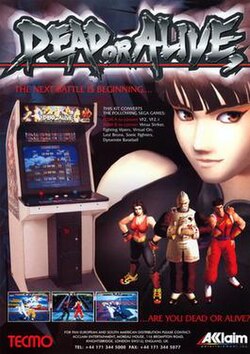Dead or Alive (video game)
| Dead or Alive | |
|---|---|

European arcade flyer
|
|
| Developer(s) | Team Ninja |
| Publisher(s) | Tecmo |
| Director(s) |
Tomonobu Itagaki Katsunori Ehara Takeshi Kawaguchi |
| Producer(s) | Tomonobu Itagaki Yujin Rikimaru Yutaka Koga |
| Designer(s) | Motohiro Shiga Jun Hasunuma |
| Writer(s) | "Asamin" |
| Composer(s) | Makoto Hosoi |
| Series | Dead or Alive |
| Platform(s) | Arcade, Sega Saturn, PlayStation |
| Release date(s) |
Arcade November 26, 1996 October 16, 1998 (++) Sega Saturn
|
| Genre(s) | Fighting game |
| Mode(s) | Up to 2 players simultaneously |
| Cabinet | Upright |
| Arcade system | Sega Model 2 |
| Display | Raster, 496 x 384 pixels (horizontal), 8192 colors |
| Aggregate scores | |
|---|---|
| Aggregator | Score |
| GameRankings | 83.92% (Saturn) 84% (PS1) |
| Metacritic | 84/100 (PS1) |
| MobyRank | 88% (Saturn) 81% (PS1) |
| Review scores | |
| Publication | Score |
| AllGame |
|
| CVG |
|
| EGM | 30.5/40 (PS1) |
| Famitsu | 31/40 (PS1) |
| GameFan | 280/300 (Saturn) |
| Game Informer | 7.75/10 (PS1) |
| GamePro | 19/20 (Saturn) 17/20 (PS1) |
| GameSpot | 6.8/10 (Saturn) 7.3/10 (PS1) |
| IGN | 8.5/10 (PS1) |
| 95% (Saturn) | |
| Sega Saturn Magazine | 92% (Saturn) |
Dead or Alive (Japanese: デッドオアアライブ Hepburn: Deddo Oa Araibu?) is a 1996 fighting game by Tecmo and the first entry in Team Ninja's long-running Dead or Alive series. It was released first in arcades, followed by home ports for the Sega Saturn in Japan, and later for the PlayStation in all regions.
Capitalizing on the success of Sega's Virtua Fighter fighting game series at the time, Dead or Alive takes influence from Virtua Fighter while adding unique gameplay elements of its own. The game also attracted attention for its presentation, which was more provocative than other mainstream 3D fighting games at the time.
Dead or Alive was a commercial success, helping Tecmo overcome their financial problems. The success of the game helped turn the series into a franchise, including several sequels and numerous spinoffs.
The gameplay of Dead or Alive was unique at the time of its debut because it featured different choices in gameplay than other early 3D fighting games. Its most defining features were its speed and countering system. Dead or Alive put an emphasis on speed, and relied more on simplistic commands and quick reaction time.
Furthermore, its countering system was the first in the fighting genre to utilize different commands that corresponded to each type of attack. There are two kinds of holds, an Offensive Hold and a Defensive Hold; the latter are executed by holding back or forward on the directional pad along with the guard input to either force away or counter-damage an opponent.
...
Wikipedia
